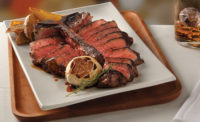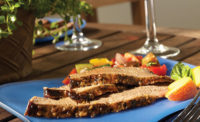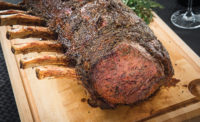Guest Column
Get Real with Beef: Regionality brings out the best






Editor’s Note: “Get Real with Beef” is a new column, written by Dr. Phil Bass, corporate meat scientist for the Certified Angus Beef® brand, and Editorial Board Member of The National Provisioner. Watch for his insights, including his take on beef cuts that processors should investigate adding to their product mix (Utilize This!), on a quarterly basis, exclusively in The National Provisioner.
|
The many regions of North America are home to their own distinctive foods, including specific beef cuts and cookery. During my time working in this great meat community, I have had the honor and privilege to travel and learn which cuts are more popular in certain areas than others. This regionality of beef can help create new demand for cuts that may have not been observed in certain parts of the country. Simply introducing a cut of meat to a region that has not traditionally favored it can help restaurants and grocery outlets differentiate without having to re-invent the entire wheel of beef marketing. A few beef cuts that have been extremely popular in only certain pockets and cultures are starting to branch out of their home kitchens, grills and smokers and into the mouths of diners all over hungry for alternatives. |
Being a native of northern California and growing up in an Italian family, the beef brisket was something of a novel item in what I would consider my routine fare. Oh sure, every St. Patrick’s Day, mom would boil the obligatory corned beef with potatoes and cabbage, but other than that, the unassuming beef brisket, lovingly harvested from our home-raised cattle, was relegated to being a mere raw ingredient for stew and ground beef.
|
Utilize This!
The beautiful ball tip The beef loin ball tip may look like three muscles with two seams, but look again. One seam fades out, so let’s consider the two muscles there. Expose the main seam and liberate the lean muscle to find enticing and tender beef, including some very nice medallion steaks. Again, you may see three smaller roasts: the Vastus lateralisand the Rectus femoris (with two “heads”). Seams removed, the resulting cuts are rather tender and delicate in flavor. Research says they perform like center-cut top sirloin steaks, especially aged 21 days or more, great for grilling. This is a perfect example of a piece that a practiced knife can transform into more tender and highly profitable items. Resulting off cuts can be steak tips or kabobs. — Dr. Phil Bass |
Not until moving to Colorado and enrolling for the final leg of my graduate studies at Colorado State University did I realize just how much the noble brisket is regaled in parts of this great country. Graduate school has the tendency to, either by design or mere luck, become a metaphorical melting pot of folks from different backgrounds and locations. As such, we graduate students not only brought our experiences and malleable minds with us, but also our cuisine. In my instance, I had the pleasure of spending time with a Texan who helped me better understand and appreciate brisket. For those who had not realized the excitement and even reverence that Texans hold for their brisket, this cut is a must at most gatherings in the Lone Star State.
Unlike the Irish tradition, Texans celebrate the brisket with a day-long, low-heat smoking ritual meant not only to enhance the flavor and tenderness of the meat, but also, I believe, to allow for bragging rights as to who can slow-smoke their brisket the longest. A variety of woods can be used, along with an infinite combination of herbs and spices to complement the buttery flavors inherent to the brisket. Regardless of the nuances, the beef brisket has become a cut that brings to mind a region of North America that is similarly unique in nature yet limitless in functionality.
There are other regional superstars of course. Unbeknownst to me until my departure from home, but California, too, has its signature cut of beef that is more popular there than nearly anywhere else in North America. The bottom sirloin tri tip is a staple beef item in the Golden State, and accompanied with stewed beans and garlic bread, it’s the quintessential barbecue item there. Most stories for the origination of the tri tip tradition lead to the central coast of California, specifically the small farming community of Santa Maria, where the vaqueros to this day dine on this fire-roasted cut. Unlike the brisket, the tri tip requires only minutes over direct heat to reach its proper doneness. Ideally, you’d use a hardwood such as oak to quickly char the outside while blending a subtle hint of smoke from the fire. It can be prepared on a propane grill or roasted in the oven. For those who don’t have the foresight or time to commit to a brisket, the tri tip is an exceptional cut that typically provides a very desirable flavor.
A jog to the opposite corner of the United States will bring up the New England states where the bottom sirloin flap is the go-to beef cut. Chunked into small pieces and cooked quickly, it creates the region’s popular steak tips entrée. Crossing over to Quebec, Canada, you will find the bottom sirloin flap on every steakhouse menu. In this French-speaking area, the bavette steak — as the sirloin flap is known — is portioned into 6- or 8-ounce (about 4 inches wide) pieces cut with the grain, quickly grilled, then sliced against the grain and fanned out for presentation. This has become one of my favorite cuts recently because it offers a tremendous amount of versatility and flavor.
Similar in grain and flavor profile, skirt steaks (outside or inside) are the favored beef cut for Southwestern U.S. Latin gastronomy; however, the high-yielding and more available bottom sirloin flap is increasingly an alternative to the traditional skirts. These cuts are thinly sliced against the grain for fajitas and will delight even the most scrutinizing palates.
Many more cuts of beef can be discussed for regional appropriation, but this is a small sampling of those that are probably the more readily identifiable and applicable. And to complete the wonders, many unique culinary traditions and preparations across the continent allow for the diverse dining experiences — either at home or in restaurants — that more and more consumers are craving.
Go beef!
Looking for a reprint of this article?
From high-res PDFs to custom plaques, order your copy today!













